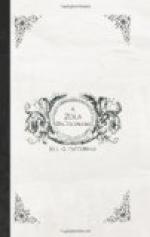LANTIER (CLAUDE), son of Gervaise Macquart and Auguste Lantier, was born at Plassans in 1842. He was brought up by his paternal grandmother, but when she died, in 1850, he was taken to Paris by his parents. La Fortune des Rougon.
After Lantier’s desertion of Gervaise, and her subsequent marriage to Coupeau, Claude continued to reside with his mother, but a few years later an old gentleman of Plassans, a lover of pictures, who had been greatly struck by some daubs done by the child, offered to pay for his education. The offer was accepted, and Claude returned to Plassans. L’Assommoir.
Some years later his benefactor died, leaving him an income of a thousand francs a year, enough to prevent him dying of hunger in the artistic career which he had decided to follow. Having come to Paris with an intense hatred of romanticism, he was struck by the artistic possibilities of the Halles Centrales, the great provision markets of Paris, which he haunted in search of subjects for his brush. He was induced by Florent to attend one of the republican meetings in Lebigre’s cafe, but was not in sympathy with the movement, and declined to take part in it. He occasionally visited his aunt, Madame Lisa Quenu, but revolted against her complete indifference to art, and her middle-class selfishness. Le Ventre de Paris.
He was appointed a member of the family council which nominally had charge of Pauline Quenu’s fortune. La Joie de Vivre.
He established himself in a studio near the roof of an old house close to the river, and there lived the life of a Bohemian, with an absolute disdain for everything not related to art. He revolted against the canons of the schools, and tried to achieve truth in painting by adopting an exaggerated realism. His hopes became centred in a large painting, which he called Plein Air, intended for exhibition in the Salon. The picture was rejected, and when shown at a minor exhibition was greeted with derision by the public. About this period began his connection with Christine Hallegrain, with whom he lived for several years, and ultimately married. They took up house at Bennecourt in an old cottage, and there some years passed happily enough, a son named Jacques Louis being born in 1860. But Claude gradually became discontented, and the family returned to Paris, where there began a long struggle against poverty, a struggle beginning in high anticipation and ending in despair. After




